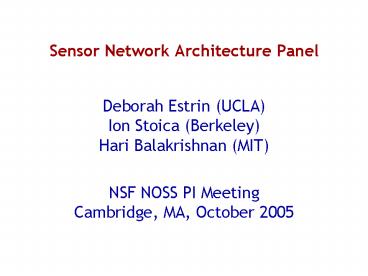Sensor Network Architecture Panel - PowerPoint PPT Presentation
1 / 13
Title:
Sensor Network Architecture Panel
Description:
Architecture (n) -- 5 : the manner in which the components of a computer or ... Sensor network architecture (n) -- Manner in which mechanisms and protocols for ... – PowerPoint PPT presentation
Number of Views:111
Avg rating:3.0/5.0
Title: Sensor Network Architecture Panel
1
Sensor Network Architecture Panel
- Deborah Estrin (UCLA)Ion Stoica (Berkeley)Hari
Balakrishnan (MIT) - NSF NOSS PI MeetingCambridge, MA, October 2005
2
Panel Charter
- What is a sensor network architecture?
- Some requirements
- Some examples
- What are some open architectural problems?
- How can our community converge on a few
architectures or architectural choices?
3
Game Plan
- Ten minutes per panelist
- Position statements loosely based on questions
- Open floor to comments, brickbats, questions,
discussion - This means you!
4
Musings on Sensor Network Architecture
- Hari BalakrishnanMIT
5
What is an Architecture?
- Architecture (n) -- 5 the manner in which the
components of a computer or computer system are
organized and integrated - Sensor network architecture (n) -- Manner in
which mechanisms and protocols for sensor
network-based acquisition, monitoring, control,
and actuation are organized - Architecture abstractions and principles, not
implementation - An architecture should, within limits, be
evolvable and permit innovation
6
Designing an Architecture
- Must start with a set of requirements
- We eventually need to agree on a core set
- We should decide whether things we dont agree on
should be optional, or eschewed - Software architecture modules interfaces
- Network architecture is more than that
7
Some Requirements
- Heterogeneity (radios, nodes, data types, )
- Common case is wireless (radio) communication
- Generality enable unforeseen applications,
accommodate variety of services - Efficiency (energy, channel capacity, congestion)
- Security
- Mobility
- Intermittent connectivity
8
Some Non-Requirements
- Same network infrastructure concurrently used by
many different applications/users - Massive amounts of multiplexing
- Point-to-point reliable connections as the common
case - Accounting and billing, autonomous entities,
greedy participants(?)
9
Sensor Network Architecture
- Addressing and naming
- Forwarding
- Channel sharing / congestion management
- Placement of various functions modules, not
layers - In-the-net processing
- Routing, reliable data delivery, transport,
numerous services (localization, timesync, etc.) - Security model
- State maintenance
- What sort of state? Who creates it? Who
maintains it? How to cope with failures?
10
Names and Addresses
- Names Arbitrary, outside scope of architecture,
no constraints - Identity Each node has an identity, a flatname
- Location/topology-independent
- E.g., hash of public key
- Address All addresses should be geographic
- Location a common attribute
- Virtual coordinates (e.g., level/sibling in
tree) - Forwarding On both ID and addresses
11
Broadcast-based Architecture
- With wires, links are shielded from one another
- Sharing starts only at network layer
- Wireless networks have no such shielding
- Radios are not wires!
- Unnatural and inefficient to think in terms of
links - Need a new abstraction that embraces broadcast
- Many new techniques frame combining,
opportunistic routing, multi-radio diversity,
network coding, etc. - Open question A broadcast-based wireless network
architecture
12
In-the-net processing State semantics
- Internet architecture soft state, fate sharing
- Does not accommodate in-the-net processing
- Our generality goal is different from the
Internet - Open question principles for how to deal with
state upon failure, churn, or other changes?
13
Summary
- Identity
- Broadcast-based design
- State management principles
- Security































